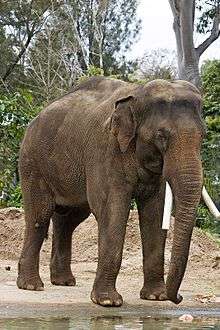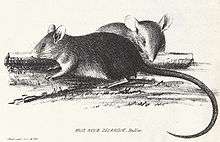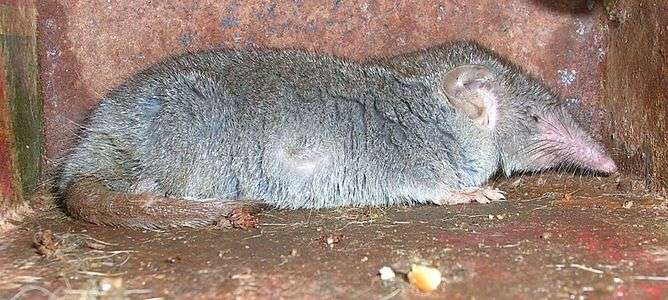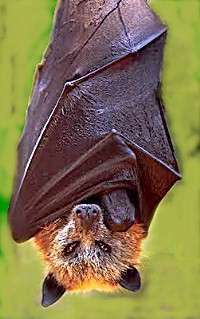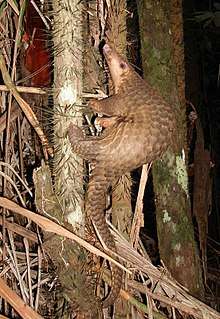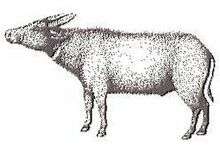List of mammals of the Philippines
This is a list of the mammal species recorded in the Philippines.
There are 210 native mammal species in the Philippines, excluding those of the order Cetacea (whales, dolphins, and porpoises) and extinct species (Pleistocene Epoch), of which around six are critically endangered, around thirteen are endangered, around thirty are vulnerable, and around two are near threatened. Eight of the species listed for the Philippines have been extinct since the Pleistocene Epoch. One fossil species of Sirenia has been found in Palawan and could have been extinct since the Miocene, the eastern-most fossil remains of any Sirenia in history, However, there are also extinct deer and pig fossil remains known in the Philippine not yet included in this list, as well as other buffalo and small mammal species from the Pleistocene Epoch. One species which became extinct in the 13th to possibly the 16th century, the Asian elephant, which was transported to the Sultanate of Sulu and Maguindanao but became extinct in those areas or whose individuals were transported back to Sabah for unknown reasons. One former species, Acerodon lucifer, is extinct, but is now highly regarded as part of the species Acerodon jubatus today, thus, the species still thrives in the archipelago, but is locally extinct on the island of Panay.
Seven species in the country have been introduced for agriculture, transportation, companionship, and tourism and has played significant roles in the livelihood of the people. One species, the sika deer, was introduced for unknown purpose, and evolved into as separate subspecies on Jolo Island, while three species (introduced accidentally through ships) are worldwide pests: the black and brown rats, and the house mouse.
The taxonomy and naming of the individual species is based on 1) The Synopsis of Philippine Mammals by the Smithsonian Institution; 2) recent articles on species discovery in the country; 3) domesticated profiles; and 4) those used in existing Wikipedia articles as of May 21, 2007 and supplemented by the common names and taxonomy from the IUCN, the Smithsonian Institution, or the University of Michigan where no Wikipedia article was available.
The following tags are used to highlight each species' conservation status as assessed by the International Union for Conservation of Nature:
| EX | Extinct | No reasonable doubt that the last individual has died. |
| EW | Extinct in the wild | Known only to survive in captivity or as a naturalized populations well outside its previous range. |
| CR | Critically endangered | The species is at imminent risk of extinction in the wild. |
| EN | Endangered | The species is facing an extremely high risk of extinction in the wild. |
| VU | Vulnerable | The species is facing a high risk of extinction in the wild. |
| NT | Near threatened | The species does not meet any of the criteria that would categorize it as risking extinction but it is likely to do so in the future. |
| LC | Least concern | There are no current identifiable risks to the species. |
| DD | Data deficient | There is inadequate information to make an assessment of the risks to this species. |
Some species were assessed using an earlier set of criteria. Species assessed using this system have the following instead of near threatened and least concern categories:
| LR/cd | Lower risk/conservation dependent | Species which were the focus of conservation programmes and may have moved into a higher risk category if that programme was discontinued. |
| LR/nt | Lower risk/near threatened | Species which are close to being classified as vulnerable but are not the subject of conservation programmes. |
| LR/lc | Lower risk/least concern | Species for which there are no identifiable risks. |
Subclass: Theria
Infraclass: Eutheria
Order: Proboscidea (elephants)
Elephants comprise three living species and are the largest living land animals. One species, the Asian elephant – unknown subspecies like those on Sabah, once lived in both the Sultanate of Sulu and Maguindanao, though became extinct on those areas because of hunting and/or were transported back to Sabah for unknown reasons.
- Family: Elephantidae (elephants)
- Genus: Elephas
- Asian elephant, Elephas maximus EN – EX in Philippines – Introduced in the 13th–16th? century from Sabah in the reign of the Sultanate of Sulu, and became extinct on Maguindanao or were transported back to Sabah. Bone fragments were the only proof left behind.[1]
- Genus: Elephas
Order: Sirenia (manatees and dugongs)
Sirenia is an order of fully aquatic, herbivorous mammals that inhabit rivers, estuaries, coastal marine waters, swamps, and marine wetlands. All four species are endangered. One species occur in the Philippines. One fossil species has been discovered in the Philippines in 2011.[2] The fossil hasn't yet been extracted from the rocks in fear of destroying the natural heritage caves of Palawan which are protected by Philippine Law. Future technology in fossil extraction is the only way to get and identify the fossil remain in peace according to the scientists who found the remains.
- Family: Dugongidae
Order: Scandentia (treeshrews)
The treeshrews are small mammals native to the tropical forests of Southeast Asia. Although called treeshrews, they are not true shrews and are not all arboreal. Three species occur in the Philippines, though the Calamian treeshrew is not yet fully considered by the IUCN as a full separate species because assessment is not yet done at present to confirm the movement as of 2013.
- Family: Tupaiidae (tree shrews)
- Genus: Tupaia
- Calamian treeshrew, Tupaia moellendorffi DD
- Palawan tree shrew, Tupaia palawanensis VU
- Genus: Urogale
- Mindanao treeshrew, Urogale everetti VU
- Genus: Tupaia
Order: Dermoptera (colugos)
The two species of colugos make up the order Dermoptera. They are arboreal gliding mammals found in Southeast Asia. Only one species occurs in the Philippines and is endemic to the Mindanao Faunal Region.
- Family: Cynocephalidae (flying lemurs)
- Genus: Cynocephalus
- Philippine flying lemur, Cynocephalus volans VU
- Genus: Cynocephalus
Order: Primates
The order Primates contains humans and their closest relatives: lemurs, lorisoids, monkeys, and apes. Three endemic species occurs in the Philippines.
- Suborder: Strepsirrhini
- Infraorder: Lemuriformes
- Superfamily: Lorisoidea
- Family: Lorisidae (lorises)
- Genus: Nycticebus
- Philippine slow loris, Nycticebus menagensis LR/lc Note: Extinct in Tawi-Tawi island, another population maybe still survive in nearby smaller island.[3]
- Genus: Nycticebus
- Family: Lorisidae (lorises)
- Superfamily: Lorisoidea
- Infraorder: Lemuriformes
- Suborder: Haplorhini
- Infraorder: Tarsiiformes
- Superfamily: Tarsioidea
- Family: Tarsiidae (tarsiers)
- Genus: Carlito
- Philippine tarsier, Carlito syrichta DD Note: Those in Dinagat Islands may be of a different subspecies because they are the biggest in the Mindanao Faunal Region. Those on Sarangani may be of different species as well. Further field research and work is heavily needed.
- Leyte-Samar tarsier, Carlito syrichta syrichta
- Bohol tarsier, Carlito syrichta fraterculus
- Mindanao tarsier, Carlito syrichta carbonarius
- Dinagat tarsier, Carlito sp. – by the UP Institute of Biology
- Philippine tarsier, Carlito syrichta DD Note: Those in Dinagat Islands may be of a different subspecies because they are the biggest in the Mindanao Faunal Region. Those on Sarangani may be of different species as well. Further field research and work is heavily needed.
- Genus: Carlito
- Family: Tarsiidae (tarsiers)
- Superfamily: Tarsioidea
- Infraorder: Simiiformes
- Parvorder: Catarrhini
- Superfamily: Cercopithecoidea
- Family: Cercopithecidae (Old World monkeys)
- Genus: Macaca
- Crab-eating macaque, Macaca fascicularis LR/nt
- Common long-tailed macaque, Macaca fascicularis fascicularis NT
- Philippine long-tailed macaque, Macaca fascicularis philippensis NT
- Crab-eating macaque, Macaca fascicularis LR/nt
- Genus: Macaca
- Family: Cercopithecidae (Old World monkeys)
- Superfamily: Cercopithecoidea
- Parvorder: Catarrhini
- Infraorder: Tarsiiformes
Order: Rodentia (rodents)
Rodents make up the largest order of mammals, with over 40% of mammalian species. They have two incisors in the upper and lower jaw which grow continually and must be kept short by gnawing. Most rodents are small though the capybara can weigh up to 45 kg (99 lb). As of 2014, 86 native species occur in the Philippines, most endemic to the archipelago. One discovered fossil species has been extinct since the Pleistocene Epoch. The number of species is speculated to rise more because of the high endemic concentration on the islands, which were mostly isolated from Mainland Asia in prehistoric times. There are also three introduced species of rodents in the archipelago; the most common introduced rodents: the house mouse, black rat, and the brown rat, which are considered worldwide pests.
- Suborder: Hystricognathi
- Family: Hystricidae (Old World porcupines)
- Genus: Hystrix
- Philippine porcupine, Hystrix pumila LR/lc
- Genus: Hystrix
- Family: Hystricidae (Old World porcupines)
- Suborder: Sciurognathi
- Family: Sciuridae (squirrels)
- Subfamily: Sciurinae
- Tribe: Pteromyini
- Genus: Hylopetes
- Palawan flying squirrel, Hylopetes nigripes LR/nt
- Genus: Petinomys
- Basilan flying squirrel, Petinomys crinitus LR/lc
- Mindanao flying squirrel, Petinomys mindanensis LC
- Genus: Hylopetes
- Tribe: Pteromyini
- Subfamily: Callosciurinae
- Genus: Exilisciurus
- Philippine pygmy squirrel, Exilisciurus concinnus LR/lc
- Genus: Sundasciurus
- Davao squirrel, Sundasciurus davensis LR/lc
- Busuanga squirrel, Sundasciurus hoogstraali LR/lc
- Northern Palawan tree squirrel, Sundasciurus juvencus EN
- Mindanao squirrel, Sundasciurus mindanensis LR/lc
- Culion tree squirrel, Sundasciurus moellendorffi LR/nt
- Philippine tree squirrel, Sundasciurus philippinensis LR/lc
- Palawan montane squirrel, Sundasciurus rabori VU
- Samar squirrel, Sundasciurus samarensis VU
- Southern Palawan tree squirrel, Sundasciurus steerii LR/nt
- Palawan white squirrel: no scientific name yet but it may belong to the genus of Sundasciurus DD
- Genus: Exilisciurus
- Subfamily: Sciurinae
- Family: Muridae (mice, rats, voles, gerbils, hamsters, etc.)
- Subfamily: Murinae
- Genus: Abditomys
- Luzon broad-toothed rat, Abditomys latidens LR/lc
- Genus: Anonymomys
- Mindoro rat, Anonymomys mindorensis VU
- Genus: Apomys
- Luzon Cordillera forest mouse, Apomys abrae LR/lc
- Luzon montane forest mouse, Apomys datae LR/lc
- Large Mindoro forest mouse, Apomys gracilirostris VU
- Mt. Apo forest mouse, Apomys hylocoetes LR/lc
- Mindanao montane forest mouse, Apomys insignis LR/lc
- Mindanao lowland forest mouse, Apomys littoralis LR/lc
- Small Luzon forest mouse, Apomys microdon LR/lc
- Least forest mouse, Apomys musculus LR/lc
- Long-nosed Luzon forest mouse, Apomys sacobianus VU
- Camiguin forest mouse, Apomys camiguinensis VU
- Aurora forest mouse, Apomys aurorae
- Banahaw forest mouse, Apomys banahao
- Mt. Tapulao forest mouse or Brown's forest mouseApomys brownorum
- Lowland Banahaw forest mouse, Apomys magnus
- Mingan forest mouse, Apomys minganensis
- Sierra Madre forest mouse, Apomys sierrae
- Zambales forest mouse, Apomys zambalensis
- Lubang Island forest mouse, Apomys sp. – scientifically published in January 2014
- Mt. Irid forest mouse, Apomys sp. – scientifically published in January 2014
- Genus: Archboldomys
- Mt Isarog shrew-mouse, Archboldomys luzonensis EN
- Sierra Madre shrew mouse, Archboldomys musseri
- Cordillera shrew-mouse, Archboldomys kalinga LC
- Genus: Batomys
- Large-toothed hairy-tailed rat, Batomys dentatus DD
- Luzon forest rat, Batomys granti LR/lc
- Mindanao hairy-tailed rat, Batomys salomonseni LR/lc
- Hamiguitan hairy-tailed rat, Batomys hamiguitan DD
- Dinagat hairy-tailed rat, Batomys russatus
- Fossil batomys, Batomys sp. EX Pleistocene
- Genus: Bullimus
- Bagobo rat, Bullimus bagobus LR/lc
- Camiguin forest rat, Bullimus gamay
- Luzon forest rat, Bullimus luzonicus LR/lc
- Genus: Carpomys
- Short-footed Luzon tree rat, Carpomys melanurus DD
- White-bellied Luzon tree rat, Carpomys phaeurus DD
- Genus?: Celaenomys. Note: There is no DNA and morphological distinction to designate this as a new genus; rather, it still may belong to the original genus, Chrotomys.
- Blazed Luzon shrew rat, Celaenomys silaceus LR/nt
- Genus: Chiropodomys
- Palawan pencil-tailed tree mouse, Chiropodomys calamianensis LR/lc
- Genus: Chrotomys
- Isarog striped shrew-rat, Chrotomys gonzalesi NT
- Mindoro striped rat, Chrotomys mindorensis LR/lc
- Luzon striped rat, Chrotomys whiteheadi VU
- Blazed Luzon shrew rat, Celaenomys silaceus LR/nt
- Sibuyan striped shrew rat, Chrotomys sibuyanensis
- Genus: Crateromys
- Dinagat Island cloud rat, Crateromys australis EN
- Panay cloudrunner, Crateromys heaneyi EN
- Ilin Island cloudrunner, Crateromys paulus CR
- Luzon bushy-tailed cloud rat, Crateromys schadenbergi VU
- Genus: Crunomys
- Northern Luzon shrew rat, Crunomys fallax DD
- Mindanao shrew rat, Crunomys melanius LR/lc
- Katanglad shrew mouse, Crunomys suncoides
- Genus: Haeromys
- Lesser ranee mouse, Haeromys pusillus VU
- Genus: Limnomys
- Gray-bellied mountain rat, Limnomys bryophilus LC
- Mindanao mountain rat, Limnomys sibuanus LR/lc
- Genus: Maxomys
- Palawan spiny rat, Maxomys panglima LR/nt
- Genus: Mus
- House mouse, Mus musculus LC – introduced
- Genus: Musseromys
- Banahaw tree mouse, Musseromys gulantang not evaluated
- Genus: Palawanomys
- Palawan soft-furred mountain rat, Palawanomys furvus EN
- Genus: Phloeomys
- Southern Luzon giant cloud rat, Phloeomys cumingi VU
- Northern Luzon giant cloud rat, Phloeomys pallidus LR/nt
- Genus: Rattus
- Rice-field rat, Rattus argentiventer LR/lc
- Philippine forest rat, Rattus everetti LR/lc
- Polynesian rat, Rattus exulans LR/lc
- Mindoro black rat, Rattus mindorensis VU
- Himalayan field rat, Rattus nitidus LR/lc
- Brown rat, Rattus norvegicus LC – introduced
- Black rat, Rattus rattus LC – introduced
- Tanezumi rat, Rattus tanezumi LC
- Tawi-tawi forest rat, Rattus tawitawiensis VU
- Malayan field rat, Rattus tiomanicus LR/lc
- Genus: Rhynchomys
- Banahao shrew-rat, Rhynchomys banahao DD
- Isarog shrew rat, Rhynchomys isarogensis VU
- Mt. Data shrew rat, Rhynchomys soricoides LR/lc
- Zambales shrew-rat, Rhynchomys tapulao DD
- Genus: Sundamys
- Müller's giant Sunda rat, Sundamys muelleri LR/lc
- Genus: Tarsomys
- Long-footed rat, Tarsomys apoensis LR/lc
- Spiny long-footed rat, Tarsomys echinatus VU
- Genus: Tryphomys
- Luzon short-nosed rat, Tryphomys adustus VU
- Genus: Abditomys
- Subfamily: Murinae
- Family: Sciuridae (squirrels)
Order: Eulipotyphla (shrews and gymnures)
The order Erinaceomorpha contains a single family, Erinaceidae, which comprise the hedgehogs and gymnures. The hedgehogs are easily recognised by their spines while gymnures look more like large rats. Two species occurs in the Philippines as of 2013, though speculation persists that perhaps there will be future moonrat species on Leyte, Samar, Basilan, or even Bohol because they were also once part of the Mindanao Faunal Region like Mindanao and Dinagat. The "shrew-forms" are insectivorous mammals. The shrews and solenodons closely resemble mice while the moles are stout-bodied burrowers. Twelve species occur in the Philippines, most of which are endemic.
- Family: Erinaceidae (hedgehogs)
- Subfamily: Galericinae
- Genus: Podogymnura
- Dinagat moonrat, Podogymnura aureospinula EN
- Mindanao moonrat, Podogymnura truei EN
- Genus: Podogymnura
- Subfamily: Galericinae
- Family: Soricidae (shrews)
- Subfamily: Crocidurinae
- Genus: Crocidura
- Grey shrew, Crocidura attenuata LR/lc
- Batak shrew, Crocidura batakorum
- Mindanao shrew, Crocidura beatus VU
- Mt. Malindang shrew, Crocidura grandis EN
- Luzon shrew, Crocidura grayi VU
- Mindoro shrew, Crocidura mindorus EN
- Negros shrew, Crocidura negrina CR
- Sibuyan shrew, Crocidura ninoyi not evaluated
- Palawan shrew, Crocidura palawanensis VU
- Panay shrew, Crocidura panayensis
- Taiwanese gray shrew, Crocidura tanakae LC -info from Field Museum
- Genus: Palawanosorex
- Palawan moss shrew, Palawanosorex muscorum
- Genus: Suncus
- Asian house shrew, Suncus murinus LR/lc
- Genus: Crocidura
- Subfamily: Crocidurinae
Order: Chiroptera (bats)
The bats' most distinguishing feature is that their forelimbs are developed as wings, making them the only mammals capable of flight. Bat species account for about 20% of all mammals. Ninety species occur in the Philippines, though the exact number of species is truly unknown because of the uneven distribution of bat species in Southeast Asia and Australasia. More additional field survey is needed in all of the 7,107 islands of the country archipelago to determine the exact species that occur in the country, and to know the exact number of species that actually live in the archipelago.
- Family: Pteropodidae (flying foxes, Old World fruit bats)
- Subfamily: Pteropodinae
- Genus: Acerodon (flying fox)
- Giant golden-crowned flying fox, Acerodon jubatus EN Note: the now extinct Panay giant fruit bat was once considered a separate species, living in Panay Island, but is now included in Acerodon jubatus.
- Palawan fruit bat, Acerodon leucotis VU
- Genus: Alionycteris
- Mindanao pygmy fruit bat, Alionycteris paucidentata VU
- Genus: Cynopterus
- Lesser short-nosed fruit bat, Cynopterus brachyotis LR/lc
- Peters's fruit bat, Cynopterus luzoniensis LC
- Genus: Desmalopex
- Mottle-winged flying fox, Desmalopex leucopterus
- Mindoro pallid flying fox, Desmalopex microleucopterus
- Genus: Dobsonia
- Philippine bare-backed fruit bat, Dobsonia chapmani CR
- Genus: Dyacopterus
- Dayak fruit bat, Dyacopterus spadiceus LR/nt
- Rickart's dyak fruit bat, Dyacopterus rickarti not evaluated
- Genus: Haplonycteris
- Philippine pygmy fruit bat, Haplonycteris fischeri VU
- Genus: Harpyionycteris
- harpy fruit bat, Harpyionycteris whiteheadi LR/lc
- Genus: Megaerops
- White-collared fruit bat, Megaerops wetmorei LR/lc
- Genus: Nyctimene
- Philippine tube-nosed fruit bat, Nyctimene rabori EN
- Genus: Otopteropus
- Luzon fruit bat, Otopteropus cartilagonodus VU
- Genus: Ptenochirus
- Greater musky fruit bat, Ptenochirus jagori LR/lc
- Lesser musky fruit bat, Ptenochirus minor LR/lc
- Genus: Pteropus
- Ryukyu flying fox or Ryukyu fruit bat, Pteropus dasymallus NT
- Gray flying-fox, Pteropus griseus LR/lc
- Small flying-fox, Pteropus hypomelanus LR/lc
- White-winged flying fox, Pteropus leucopterus EN
- Mearns's flying fox, Pteropus mearnsi DD
- Little golden-mantled flying fox, Pteropus pumilus NT
- Philippine gray flying fox, Pteropus speciosus DD
- Large flying fox, Pteropus vampyrus LR/lc
- Genus: Styloctenium (striped-faced fruit bats)
- Mindoro stripe-faced fruit bat, Styloctenium mindorensis not evaluated
- Genus: Acerodon (flying fox)
- Subfamily: Rousettinae
- Genus: Rousettus
- Geoffroy's rousette, Rousettus amplexicaudatus LR/lc
- Genus: Rousettus
- Subfamily: Macroglossinae
- Genus: Macroglossus
- Long-tongued nectar bat, Macroglossus minimus LR/lc
- Genus: Eonycteris
- Greater dawn bat, Eonycteris major DD
- Lesser dawn bat, Eonycteris spelaea LC
- Philippine dawn bat, Eonycteris robusta NT
- Genus: Macroglossus
- Subfamily: Pteropodinae
- Family: Vespertilionidae
- Subfamily: Kerivoulinae
- Genus: Kerivoula
- Hardwicke's woolly bat, Kerivoula hardwickii LR/lc
- Papillose woolly bat, Kerivoula papillosa
- Clear-winged woolly bat, Kerivoula pellucida LR/lc
- Whitehead's woolly bat, Kerivoula whiteheadi LR/lc
- Genus: Phoniscus
- Peter's trumpet-eared bat, Phoniscus jagorii LR/lc
- Genus: Kerivoula
- Subfamily: Myotinae
- Genus: Myotis
- Peters's myotis, Myotis ater LR/lc
- Hodgson's bat, Myotis formosus LR/lc
- Horsfield's bat, Myotis horsfieldii LR/lc
- Pallid large-footed myotis, Myotis macrotarsus LR/nt
- Whiskered myotis, Myotis muricola LR/lc
- Orange-fingered myotis, Myotis rufopictus
- Genus: Myotis
- Subfamily: Vespertilioninae
- Genus: Falsistrellus
- Pungent pipistrelle, Falsistrellus mordax LR/nt
- Peters's pipistrelle, Falsistrellus petersi LR/lc
- Genus: Glischropus
- Common thick-thumbed bat, Glischropus tylopus LR/lc
- Genus: Philetor
- Rohu's bat, Philetor brachypterus LR/lc
- Genus: Pipistrellus
- Java pipistrelle, Pipistrellus javanicus LR/lc
- Least pipistrelle, Pipistrellus tenuis LR/lc
- Narrow-winged pipistrelle, Pipistrellus stenopterus
- Genus: Scotophilus (yellow bats)
- Greater Asiatic yellow bat, Scotophilus heathi LR/lc
- Lesser Asiatic yellow bat, Scotophilus kuhlii LR/lc
- Genus: Tylonycteris (bamboo bats)
- Lesser bamboo bat, Tylonycteris pachypus LR/lc
- Greater bamboo bat, Tylonycteris robustula LR/lc
- Genus: Falsistrellus
- Subfamily: Murininae
- Genus: Harpiocephalus (hairy-winged bats)
- Lesser hairy-winged bat, Harpiocephalus harpia LR/lc
- Genus: Murina
- Round-eared tube-nosed bat, Murina cyclotis LR/lc
- Brown tube-nosed bat, Murina suilla
- Genus: Harpiocephalus (hairy-winged bats)
- Subfamily: Miniopterinae
- Genus: Miniopterus
- Little long-fingered bat, Miniopterus australis LR/lc
- Intermediate long-fingered bat, Miniopterus medius LR/lc
- Small bent-winged bat, Miniopterus pusillus LR/lc
- Schreibers' long-fingered bat, Miniopterus schreibersii LC
- Great bent-winged bat, Miniopterus tristis LR/lc
- Genus: Miniopterus
- Subfamily: Kerivoulinae
- Family: Molossidae
- Genus: Chaerephon (Old World free-tailed bats)
- Wrinkle-lipped free-tailed bat, Chaerephon plicata LR/lc
- Genus: Cheiromeles (hairless bats)
- Lesser naked bat, Cheiromeles parvidens LC
- Hairless bat, Cheiromeles torquatus LR/nt
- Genus: Mops
- Sulawesi free-tailed bat, Mops sarasinorum LR/nt
- Genus: Otomops
- Otomops sp. – unknown species, caught by Field Museum
- Genus: Chaerephon (Old World free-tailed bats)
- Family: Emballonuridae
- Genus: Emballonura
- Small Asian sheath-tailed bat, Emballonura alecto LR/lc
- Genus: Saccolaimus (pouched bats)
- Naked-rumped pouched bat, Saccolaimus saccolaimus LR/lc
- Genus: Taphozous (tomb bats)
- Black-bearded tomb bat, Taphozous melanopogon LR/lc
- Genus: Emballonura
- Family: Megadermatidae
- Genus: Megaderma
- Lesser false vampire bat, Megaderma spasma LR/lc
- Genus: Megaderma
- Family: Rhinolophidae
- Subfamily: Rhinolophinae
- Genus: Rhinolophus (horseshoe bats)
- Acuminate horseshoe bat, Rhinolophus acuminatus LR/lc
- Andersen's horseshoe bat, Rhinolophus anderseni DD
- Arcuate horseshoe bat, Rhinolophus arcuatus LR/lc
- Bornean horseshoe bat, Rhinolophus borneensis LC
- Creagh's horseshoe bat, Rhinolophus creaghi NT
- Philippine forest horseshoe bat, Rhinolophus inops DD
- Big-eared horseshoe bat, Rhinolophus macrotis LR/lc
- Large-eared horseshoe bat, Rhinolophus philippinensis LR/nt
- Large rufous horseshoe bat, Rhinolophus rufus LR/nt
- Small rufous horseshoe bat, Rhinolophus subrufus VU
- Yellow-faced horseshoe bat, Rhinolophus virgo LR/nt
- Genus: Rhinolophus (horseshoe bats)
- Subfamily: Rhinolophinae
- Family: Hipposiderinae
- Genus: Coelops (tailless leaf-nosed bats)
- Philippine tailless leaf-nosed bat, Coelops hirsutus DD
- Genus: Hipposideros (roundleaf bats)
- Dusky roundleaf bat, Hipposideros ater LR/lc
- Bicolored roundleaf bat, Hipposideros bicolor LR/lc
- Fawn roundleaf bat, Hipposideros cervinus LR/lc
- Large Mindanao roundleaf bat, Hipposideros coronatus LR/nt
- Diadem roundleaf bat, Hipposideros diadema LR/lc
- Large Asian roundleaf bat, Hipposideros lekaguli LR/nt
- Philippine forest roundleaf bat, Hipposideros obscurus LR/nt
- Philippine pygmy roundleaf bat, Hipposideros pygmaeus LR/nt
- Genus: Coelops (tailless leaf-nosed bats)
Order: Pholidota (pangolins)
The order Pholidota comprises the eight species of pangolin. Pangolins are anteaters and have the powerful claws, elongated snout and long tongue is seen in the other unrelated anteater species. One species occurs in the Philippines, the Philippine pangolin which was elevated to full species status from the Sunda pangolin.
- Family: Manidae
- Genus: Manis
- Philippine pangolin, Manis culionensis LR/nt
- Genus: Manis
Order: Cetacea (whales)
_(6206904718).jpg)
The order Cetacea includes whales, dolphins and porpoises. They are the mammals most fully adapted to aquatic life with a spindle-shaped nearly hairless body, protected by a thick layer of blubber, and forelimbs and tail modified to provide propulsion underwater. The number of Cetacea species that occur in the Philippines is critically unsure. More research and field work is needed to confirm the exact number.
- Suborder: Mysticeti
- Family: Balaenopteridae
- Subfamily: Balaenopterinae
- Genus: Balaenoptera
- Minke whale, Balaenoptera acutorostrata LR/nt
- Omura's whale, Baleanoptera omurai DD
- Bryde's whale, Balaenoptera edeni DD
- Sei whale, Balaenoptera borealis EN
- Fin whale, Balaenoptera physalus EN
- Blue whale, Baleenoptera musculus EN
- Genus: Balaenoptera
- Subfamily: Megapterinae
- Genus: Megaptera
- Humpback whale, Megaptera novaeangliae VU
- Genus: Megaptera
- Subfamily: Balaenopterinae
- Family: Balaenopteridae
- Suborder: Odontoceti
- Superfamily: Platanistoidea
- Family: Phocoenidae
- Genus: Neophocaena
- Finless porpoise, Neophocaena phocaenoides DD
- Genus: Neophocaena
- Family: Kogiidae
- Genus: Kogia
- Pygmy sperm whale, Kogia breviceps LR/lc
- Dwarf sperm whale, Kogia sima LR/lc
- Genus: Kogia
- Family: Physeteridae
- Genus: Physeter
- Sperm whale, Physeter macrocephalus VU
- Genus: Physeter
- Family: Ziphidae
- Subfamily: Hyperoodontinae
- Genus: Mesoplodon
- Blainville's beaked whale, Mesoplodon densirostris DD
- Ginkgo-toothed beaked whale, Mesoplodon ginkgodens DD
- Genus: Indopacetus
- Tropical bottlenose whale, Indopacetus pacificus DD
- Genus: Ziphius
- Cuvier's beaked whale, Ziphius cavirostris LR/lc
- Genus: Mesoplodon
- Subfamily: Hyperoodontinae
- Family: Delphinidae (marine dolphins)
- Genus: Steno
- Rough-toothed dolphin, Steno bredanensis DD
- Genus: Sousa
- Indo-Pacific humpbacked dolphin, Sousa chinensis DD
- Genus: Tursiops
- Indo-Pacific bottlenose dolphin, Tursiops aduncus DD
- Common bottlenose dolphin, Tursiops truncatus LR/lc
- Genus: Stenella
- Pantropical spotted dolphin, Stenella attenuata LR/cd
- Striped dolphin, Stenella cueruleoalba LR/lc
- Spinner dolphin, Stenella longirostris LR/cd
- Gray's spinner dolphin, Stenella longirostris longirostris
- Dwarf spinner dolphin, Stenella longirostris roseiventris
- Genus: Lagenodelphis
- Fraser's dolphin, Lagenodelphis hosei DD
- Genus: Grampus
- Risso's dolphin, Grampus griseus DD
- Genus: Peponocephala
- Melon-headed whale, Peponocephala electra LR/lc
- Genus: Feresa
- Pygmy killer whale, Feresa attenuata DD
- Genus: Orcinus
- Orca, Orcinus orca LR/cd
- Genus: Pseudorca
- False killer whale, Pseudorca crassidens LR/lc
- Genus: Globicephala
- Pilot whale, Globicephala macrorhynchus LR/cd
- Genus: Orcaella
- Irrawaddy dolphin, Orcaella brevirostris DD
- Genus: Steno
- Family: Phocoenidae
- Superfamily: Platanistoidea
Order: Carnivora (carnivorans)

There are over 260 species of carnivorans, the majority of which feed primarily on meat. They have a characteristic skull shape and dentition. Seven native species occurs in the Philippines, the second smallest number of carnivore species in any of the Asia-Pacific region countries, next to East Timor. And the smallest number in Southeast Asia compared to land size. One species or subspecies has been introduced: the domestic cat, although its origin is uncertain whether it originated from the leopard cat (though thought by some as introduced in the Visayas from Palawan) in the country or migrated with the Malays, or from Spain and America, or more than two of the former theories. Two subspecies are introduced to the country, the dingo which became extinct 15,000 years ago (dingo migration theory), and the aspin ( the term for the domestic dog in the Philippines) which probably evolved from the dingo.
- Suborder: Feliformia
- Family: Felidae
- Subfamily: Felinae
- Genus: Felis
- Domestic cat, Felis catus or Felis silvestris catus – introduced
- Genus: Prionailurus
- Genus: Felis
- Subfamily: Felinae
- Family: Viverridae (civets, mongooses, etc.)
- Subfamily: Paradoxurinae
- Genus: Arctictis
- Binturong, Arctictis binturong LR/lc
- Palawan binturong, Arctictis binturong whitei not evaluated, probably VU
- Binturong, Arctictis binturong LR/lc
- Genus: Paradoxurus
- Asian palm civet, Paradoxurus hermaphroditus (native to Palawan; populations from the other Philippines islands possibly introduced[5][6]) LR/lc
- Philippine palm civet, Paradoxurus hermaphroditus philippinensis
- Asian palm civet, Paradoxurus hermaphroditus (native to Palawan; populations from the other Philippines islands possibly introduced[5][6]) LR/lc
- Genus: Viverra
- Malayan civet, Viverra tangalunga (native to Palawan; populations from the rest of Philippines islands possibly introduced[7]) LR/lc
- Genus: Arctictis
- Subfamily: Paradoxurinae
- Family: Herpestidae (mongooses)
- Genus: Herpestes
- Collared mongoose, Herpestes semitorquatus[8] LR/lc
- Genus: Herpestes
- Family: Felidae
- Suborder: Caniformia
- Family: Canidae (dogs, foxes)
- Family: Mustelidae (mustelids)
- Genus: Mydaus
- Palawan stink badger, Mydaus marchei VU
- Genus: Amblonyx
- Asian small-clawed otter, Amblonyx cinereus NT
- Genus: Mydaus
Order: Perissodactyla (odd-toed ungulates)
The odd-toed ungulates are browsing and grazing mammals. They are usually large to very large and have relatively simple stomachs and a large middle toe. One species was introduced from Malaysia (probably from Saudi Arabia) and was bred with those that were imported from Spain when the Spaniards built the Spanish East Indies in the Philippines in the 16th century.
- Family: Equidae
- Genus: Equus
- Wild horse, Equus ferus
- Domestic horse, Equus ferus caballus – domesticated when introduced, Note: The first horses were introduced by Malays, then the second wave from the Spaniards, thus creating a unique Malay-Spanish breed of horse.
- Genus: Equus
Order: Artiodactyla (even-toed ungulates)
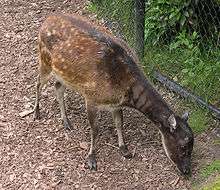
The even-toed ungulates are ungulates whose weight is borne about equally by the third and fourth toes, rather than mostly or entirely by the third as in perissodactyls. There are about 220 artiodactyl species, including many that are of great economic importance to humans. 10 native species occur in the Philippines, including the Sus populations in Tawi-tawi Province which are the only Bornean bearded pigs in the country. 5 introduced species occurs in the country: 1.) The carabao, which originated from the water buffalo in Mainland Asia, 2.) The domesticated goat – Philippine breed, 3.) The domesticated pig, though some domesticated pigs in the country originated from native Sus species like those of Banaue, 4.) The domestic cattle, which hybridized from the banteng, and Mexican domestic cattle, forming the breed, Philippine cattle which is further divided into 4 varieties, 5.) The Jolo sika deer which was anciently introduced to Sulu (unknown date, unknown subspecies origin), though it might be already extinct.
- Family: Suidae (pigs)
- Subfamily: Suinae
- Genus: Sus Note: New undescribed species might be present in Tawi-tawi in ARMM, Bilatan in Dinagat Islands Area, and Tablas Island in Romblon Province.
- Palawan bearded pig, Sus ahoenobarbus VU
- Bornean bearded pig, Sus barbatus LR/lc, probably EX in the Philippines.[9]
- Visayan warty pig, Sus cebifrons CR Note: Those on Masbate Island might still exist though sight of pigs on the island are now at present extremely rare or none at all. More field research and conducts are needed.
- Cebu warty pig, Sus cebifrons cebifrons EX
- Negros warty pig, Sus cebifrons negrinus CR
- Panay warty pig, Sus cebifrons -?- – Possible new subspecies (Tomowo Ozawa pers. comm. and in prep))
- Oliver's warty pig, Sus oliveri EN
- Philippine warty pig, Sus philippensis VU
- Luzon warty pig, Sus philippensis philippensis
- Mindanao warty pig, Sus philippensis mindanensis
- Sulu warty pig, Sus grovesi – This species was described in 2003 in an unpublished manuscript by Karen Rose and Peter Grubb but their analysis remains to be confirmed through additional craniometric and genetic analysis.
- Wild boar, Sus scrofa – domesticated when introduced
- Domestic pig, Sus scrofa domesticus or Sus domesticus – domesticated
- Genus: Sus Note: New undescribed species might be present in Tawi-tawi in ARMM, Bilatan in Dinagat Islands Area, and Tablas Island in Romblon Province.
- Subfamily: Suinae
- Family: Tragulidae
- Genus: Tragulus
- Philippine mouse-deer, Tragulus nigricans EN
- Genus: Tragulus
- Family: Cervidae (deer)
- Subfamily: Cervinae
- Genus: Cervus
- Philippine spotted deer, Rusa alfredi EN Note: Both possible subspecies have been separated for ten thousand years or so, thus subspecies clarification can be done, but no significant studies on DNA difference has yet been conducted.
- Panay spotted deer, Cervus alfredi -?- – difference unstudied
- Negros spotted deer, Cervus alfredi -?- – difference unstudied
- Philippine sambar, Rusa marianna VU
- Luzon deer, Cervus mariannus marianna
- Mindoro deer, Cervus mariannus barandana
- Upland Mindanao deer, Cervus mariannus nigella
- Lowland Mindanao deer, Cervus mariannus nigricans
- Sika deer, Cervus nippon
- Jolo sika deer, Cervus nippon soloensis Anciently introduced in Jolo island (unknown subspecies origin), probably extinct DD
- Philippine spotted deer, Rusa alfredi EN Note: Both possible subspecies have been separated for ten thousand years or so, thus subspecies clarification can be done, but no significant studies on DNA difference has yet been conducted.
- Genus: Axis
- Calamian deer, Hyelaphus calamianensis EN
- Genus: Cervus
- Subfamily: Cervinae
- Family: Bovidae (cattle, antelope, sheep, goats)
- Subfamily: Bovinae
- Genus: Bos
- Cattle, Bos taurus taurus – domesticated/introduced
- Genus: Bubalus
- Water buffalo, Bubalus bubalis – domesticated/introduced
- Carabao, Bubalus bubalis carabanesis – domesticated
- Tamaraw, Bubalus mindorensis CR Note: dwarf buffalo also once existed on Luzon and Panay but the species clarification is uncertain.
- Water buffalo, Bubalus bubalis – domesticated/introduced
- Genus: Bos
- Subfamily: Caprinae
- Subfamily: Bovinae
See also
Notes
- "7 Prehistoric Animals You Didn't Know Once Roamed the Philippines". August 4, 2014.
- lacks reference
- Nekaris, A.; Streicher, U. (2008). "Nycticebus menagensis". IUCN Red List of Threatened Species. 2008: e.T39760A10263652. doi:10.2305/IUCN.UK.2008.RLTS.T39760A10263652.en. Retrieved January 15, 2020.
- Patel, R.P.; Wutke, S.; Lenz, D.; Mukherjee, S.; Ramakrishnan, U.; Veron, G.; Fickel, J.; Wilting, A.; Förster, D. (2017). "Genetic Structure and Phylogeography of the Leopard Cat (Prionailurus bengalensis) Inferred from Mitochondrial Genomes". Journal of Heredity. 108 (4): 349–360. doi:10.1093/jhered/esx017. PMID 28498987.
- Patou, M.L.; Wilting, A.; Gaubert, P.; Esselstyn, J.A.; Cruaud, C.; Jennings, A.P.; Fickel, J.; Veron, G. (2010). "Evolutionary history of the Paradoxurus palm civets–a new model for Asian biogeography". Journal of Biogeography. 37 (11): 2092–2093. doi:10.1111/j.1365-2699.2010.02364.x.
- Piper, P.J.; Ochoa, J.; Robles, E.C.; Lewis, H.; Paz, V. (2011). "Palaeozoology of Palawan Island, Philippines". Quaternary International. 233 (2): 142–158. Bibcode:2011QuInt.233..142P. doi:10.1016/j.quaint.2010.07.009.
- Veron, G.; Willsch, M.; Dacosta, V.; Patou, M-L.; Seymour, A.; Bonillo, C.; Couloux, A.; Wong, S.T.; Jennings, A.P.; Fickel, J.; Wilting, A. (2014). "The distribution of the Malay civet Viverra tangalunga (Carnivora: Viverridae) across Southeast Asia: natural or human-mediated dispersal?". Zoological Journal of the Linnean Society. 170 (4): 917–932. doi:10.1111/zoj.12110.
- Veron, G.; Patou, M-L.; Debruyne, R.; Couloux, A.; Fernandez, D.A.P.; Wong, S.T.; Fuchs, J.; Jennings, A.P. (2015). "Systematics of the Southeast Asian mongooses (Herpestidae, Carnivora): solving the mystery of the elusive collared mongoose and Palawan mongoose". Zoological Journal of the Linnean Society. 173: 236–248. doi:10.1111/zoj.12110.
- Luskin, M.; Ke, A.; Meijaard, E.; Gumal, M.; Kawanishi, K. (2017). "Sus barbatus (errata version published in 2018)". IUCN Red List of Threatened Species. 2017: e.T41772A123793370. doi:10.2305/IUCN.UK.2017-3.RLTS.T41772A44141317.en. Retrieved January 15, 2020.{{cite iucn}}: error: |doi= / |page= mismatch (help)
References
- "The IUCN Red List of Threatened Species: Mammals of the Philippines". IUCN. 2001. Retrieved May 22, 2007.
- "Mammal Species of the World". Smithsonian National Museum of Natural History. 2005. Archived from the original on April 27, 2007. Retrieved May 22, 2007.
- "Animal Diversity Web". University of Michigan Museum of Zoology. 1995–2006. Retrieved May 22, 2007.

